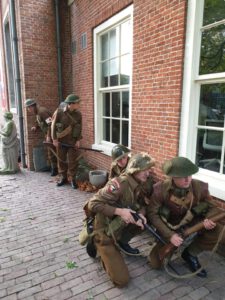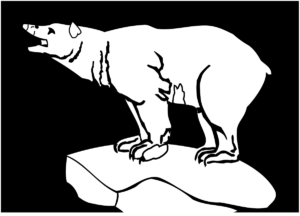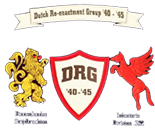The Fighting 4th Living History heeft naast no4 Army Commando en The Parachute Regiment, een derde uitbeelding: the 7th Battallion the Duke of Wellington’s Regiment. Deze eenheid was een infanterie battallion van de 49th Infantry Division; the Polar Bears. De Polar bears hebben deel genomen aan hevige gevechten in Normandie. Ze kwamen aan land op 12 Juni 1944 en vochten tot de val van de Duitsers in Falaise. Daarna werden ze onderdeel van de 2nd Canadian Army corps, ze hebben onder ander in Noord Brabant gevochten in het najaar van 1944 en in de Betuwe tijdens de winter. Maar de Polar Bears zijn vooral bekend als de bevrijders van Arnhem, Utrecht en uiteindelijk Amsterdam. Onze groep laat zien wat was een infantry section and support section binnen een peloton. Dat steeds met de hoge eisen en realisme bekend van the Fighting 4th Living History.
——
Die Gruppe Fighting 4th Living History, bekannt für die Porträts des Armeekommandos No4 und des Fallschirmjägerregiments, hat seit 2020 ein 3. Porträt: das 7. Diese Einheit war Teil der 49. Infanteriedivision: die Eisbären. Die Eisbären haben in der Normandie hart gekämpft. Am 12. Juni gelandet, blieben sie dort bis zum Fall der Falaise-Tasche. Dann in das 2. kanadische Armeekorps integriert, kämpften sie in den Niederlanden, im Herbst in Le Noord Brabant und im Winter in Betuwe. Am bekanntesten sind sie jedoch als Befreier von Arnheim, Utrecht und Amsterdam. Unsere Gruppe repräsentiert eine Infanterieabteilung (Gruppe) und eine Unterstützungsabteilung innerhalb eines Infanteriezuges (Sektion), alle mit der Qualität und dem Realismus, die aus Fighting 4th Living History bekannt sind.
——
The Fighting 4th Living History has a third portray next to their no4 Army Commando en The Parachute Regiment: the 7th Battallion the Duke of Wellington’s Regiment. This unit was an infantry battallion of the 49th Infantry Division: the Polar Bears. The Polar bears took part in heavy fights in Normandy, they arrived the 12th of June en fought until the fall of the Falaise pocket. After this, the Division became part of the 2nd Canadian Army corps. They fought inthe Netherlands, in Noord-Brabant during the autumn of 1944 and in the Betuwe during the winter. But the Polar Bears are mostly known as the liberators of Arnhem, Utrecht and Amsterdam. Our group portrays an infantry section and a support section within an infantry platoon, this with the high quality standards and realism known in the Fighting 4th Living History.
——–
Le groupe Fighting 4th Living History, connu pour les portraits du no4 Army Commando et The Parachute Regiment, a depuis 2020 un 3ème portrait: the 7th Battallion the Duke of Wellington’s Regiment. Cette unité faisait partie de la 49th Infantry Division: the Polar Bears. Les Polar Bears ont fortement combattu en Normandie. Débarqués le 12 Juin, ils y restèrent jusqu’à la chute de la poche de Falaise. Puis intégrés au sein du 2ème Corps d’Armée Canadien ils combattirent aux Pays-Bas, dans Le Noord Brabant à l’automne et dans le Betuwe durant l’Hiver. Mais ils sont surtout connus comme les libérateurs d’Arnhem, Utrecht et Amsterdam. Notre groupe représente une section (groupe) d’infanterie et une section de support aus sein d’un peloton (section) d’infanterie, le tout avec la qualité et le réalisme connus du Fighting 4th Living History.



